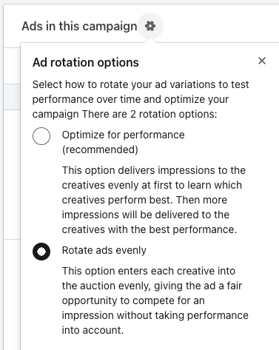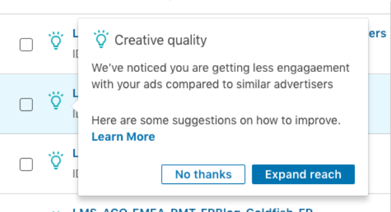
By Ava Champion, Content Specialist, and Lindsey Glorioso, Digital Marketer.
B2B businesses looking to generate leads with paid advertising should consider LinkedIn since it offers an impactful way for businesses to reach and connect with their audiences. 89% of B2B marketers use LinkedIn for lead generation1, and LinkedIn boasts an impressive community of over 900 million members and 58.4 million companies.2
4 out of 5 |
2X |
6X |
|
4 out of 5 LinkedIn members drive business decisions |
Audiences on LinkedIn have 2x the buying power of the average web audience |
Audiences on LinkedIn are 6x more likely to convert3 |
B2B businesses should tap into the potential LinkedIn offers. However, a higher conversion rate doesn’t necessarily mean those conversions are qualified leads.
At Ironpaper, our goal for lead generation is always quality over quantity. Layering that philosophy with our expertise in running ad campaigns is when LinkedIn advertising starts to provide real value to B2B businesses.
Since there are many options when running campaigns, LinkedIn offers best practices for successful targeting and recommendations for ad optimization. Many of the recommendations are helpful, but campaigns require expertise to set up and monitor. Automatically accepting LinkedIn’s recommendations won’t always help B2B marketers meet their advertising goals and budgets.
Here are some LinkedIn optimization recommendations we don’t always implement and what we do instead to draw in qualified leads for our clients.
Request a proposal today to see how we can grow your business with qualified leads.
There are several factors to consider with graphics when setting up LinkedIn advertising campaigns. Beyond the image and design of the graphic, there are rotation and dimension options.
LinkedIn’s description of ad rotation is as follows:
“You can enable ad rotation when you create a new campaign or edit an existing campaign. When you set up ad rotation, you will have the option to Rotate ads evenly or Optimize for performance. When you select Optimize for performance, our system delivers impressions to your highest performing ads more often.”4
For our clients, we usually choose to rotate ads evenly. We want to make the call on which ads are performing best since we may also be reviewing other criteria that LinkedIn doesn’t consider when determining the “winner.”
If we used LinkedIn’s Optimize ad rotation for our clients, we wouldn’t have a proper test since LinkedIn might decide prematurely that one ad version is better. 
Not only is testing important to the learning process, but it’s also a fundamental part of Ironpaper’s methodology. Iteration allows us to identify which ads engage each client’s buyers since clients, campaigns, and audiences aren’t one-size-fits-all.
We test ads for two to four weeks before rotating to observe what resonates with the client’s target audience. One combination of messaging and image might work for one client but not another, so we dedicate time to determine what works best. Once we know what resonates with that client’s specific audience, we can manually make adjustments to continue iteration and optimization.
When running ad campaigns, there are three ad image dimensions to choose from:
LinkedIn specifically recommends and promotes vertical ads for “best performance on CTR on mobile.”5 While we have found this accurate for some clients, we don’t always see a correlation between CTR (click-through rate), conversion rate, and lead qualification from ads with vertical images.
A higher CTR doesn’t mean those clicks result in qualified lead generation or new revenue. And since LinkedIn charges businesses for those clicks, we’re more interested in the quality than quantity of those clicks.
 Depending on the client, we have determined that in some cases, horizontal or square are better, particularly for an audience that spends more time on a desktop. Since vertical only displays on mobiles, this type of ad misses anyone strictly using LinkedIn on a desktop or laptop.
Depending on the client, we have determined that in some cases, horizontal or square are better, particularly for an audience that spends more time on a desktop. Since vertical only displays on mobiles, this type of ad misses anyone strictly using LinkedIn on a desktop or laptop.
We use vertical ads for clients trying to reach an audience that predominantly works “in the field” or remotely, where vertical ads can be an incredible boon.
LinkedIn offers several campaign bidding strategies that vary in ad format and campaign goals. These strategies include maximum delivery (automated), cost cap, and manual bidding.
LinkedIn’s Campaign Manager will offer recommended bids for campaigns running on either cost cap or manual bidding. “The suggested range represents an estimate of the current competing costs or bids by other advertisers who are targeting the same audience.” 6
Generally, we start around the recommended bid but have found success adjusting up or down as we continue to test or iterate.
LinkedIn promotes maximum delivery as a better return on investment (ROI) and optimized results, but these campaigns are charged by impressions (CPM) and don’t have the option to set a bid or cost cap.
This means maximum delivery tends to be more expensive and provides less control over budget utilization than manual bidding, which depends on campaign goals and budget.
The audience is critical to running lead-generating campaigns. Successful B2B advertising targets the right audience and converts them to qualified leads. Since most B2B sales include multiple decision-makers, there are a few factors to consider when selecting the right target audience.
LinkedIn has a minimum audience size requirement of 300 members to run advertising campaigns. However, they highly recommend targeting at least 50,000 members to see full results.
“We recommend the following audience sizes for LinkedIn's advertising products. Keep in mind; there's no one-size-fits-all recommendation which is why testing is crucial:
For general targeting, this audience size makes sense and is fairly targeted. But most of our large clients have audiences under 10,000 people — even under 1,500 at times.
Even with fewer audience members, our client campaigns still perform well because our messaging targets a niche audience of decision-makers, making all the difference. Due to the niche industries we work with, a larger audience might get more impressions, click-throughs, and conversions, but it’s not necessarily the people we want to convert.
We are hyper-focused on quality leads because it’s a better use of ad spend. If a client received ten leads and paid $100 for each, but only two were sales-qualified leads, this functionally brings the cost of sales-qualified leads to $500 each.
If we focus on the ideal buyer, reach them where they are, and speak directly to their company pain points, we ultimately gain more qualified leads for our B2B clients.
In the instances of receiving less qualified conversions, it is essential to learn and test, whether that means further narrowing the audience or adjusting messaging to achieve better results and bring the cost down in the future.
LinkedIn describes the audience network as follows:
“The LinkedIn Audience Network allows you to extend the reach of your Sponsored Content campaigns by delivering your ads beyond the LinkedIn feed to members on trusted third-party apps and sites.”8
It is promoted as a way for businesses to scale campaigns and increase reach with targeted audiences. However, we’ve found it decreases the quality of our results, and we tend to avoid using the audience network option.
Since LinkedIn’s advertising is widely used, the social media platform has a lot of data and performance analysis from current and previous campaigns across many businesses and industries. This is why their recommendations are broad and generic. When we layer the recommendations with our team’s experience and expertise, they start to provide value.
What it comes down to is B2B businesses knowing their prospects. Implementing LinkedIn’s recommendations without consideration won’t provide insight or knowledge about a specific audience.
Even with custom targeting based on audience segmentation, the recommendations aren’t accounting for highly specific industries and highly-targeted buyers.
AI platforms with technical algorithms are great. Still, to a certain point, they can’t replace someone looking at it daily.
Sources:
1 LinkedIn, LinkedIn Lead Gen Forms Playbook: 10 Ways to Supercharge Your Lead Gen Strategy, October 2019
2 LinkedIn Pressroom, About Us
3 LinkedIn Marketing Solutions, Why Advertise on LinkedIn
4 LinkedIn Help, LinkedIn Ad Creatives — Best Practices, June 2021
5 LinkedIn Marketing Solutions, Single Image Ads
6 LinkedIn Help, Campaign bidding strategies, March 2023
7 LinkedIn Help, Target Audience Size – Best Practices, January 2021
8 LinkedIn Help, LinkedIn Audience Network, February 2023
by Jonathan Franchell, CEO of Ironpaper - For more tips and hacks: Need to remove a new line after h1 tags? Both web designers and SEO practitioners need to employ headline tags: H1, H2, H3 in several ways to improve web page structure and tag...

The marketing industry is transforming significantly due to generative AI and increasing market complexity. Gartner's prediction of a 25% decline in traditional search traffic suggests that the era of search engines is dying. AI tools, particularly...

The Crowded Arena of the IT Marketplace Updated December 2024 The Information Technology (IT) landscape is experiencing rapid growth and intensifying competition. IT spending is projected to reach nearly 5.1 trillion U.S. dollars in 2024, a...

Updated December, 2024 The field of digital marketing is evolving rapidly in response to new technology and changing buyer expectations. To help career-minded marketers, we’ve rounded up the top 10 skills needed to succeed in the field. These are...
